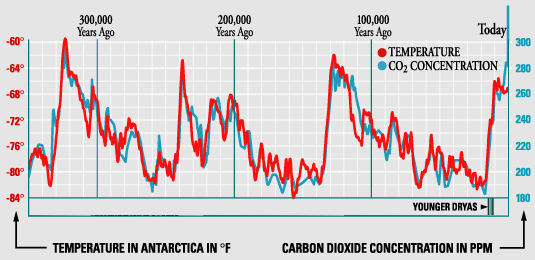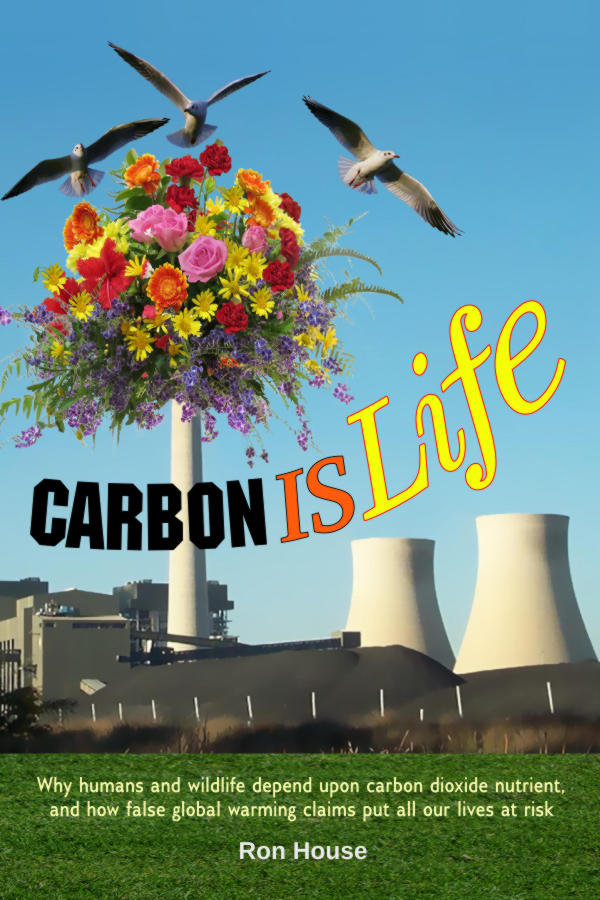The other day I found myself outside a newly-discovered library, and so naturally a few seconds later I was walking in. Aha! Book shelves! Walked up, pulled out the very first book on the shelf, and it was James Hanson's “Storms of My Grandchildren”. Hanson is, for those who came late, an adjunct professor in the Department of Earth and Environmental Sciences at Columbia University. He is one of the key promoters of catastrophic anthropomorphic global warming (CAGW), and his testimonies and activism have done much to promote the theory.
The reason I rejected CAGW in 2008 when I first looked at the global warming dispute was that I easily found evidence that contradicted the theory, but, having looked long and hard for solid science backing the CAGW claims, I never found any. So, with Hanson's book in my hand, I wondered if this might be a serendipitous moment; perhaps this book contained what I had been looking for? So I found a comfy chair.
Unfortunately, for a book written by a scientist, it was harder than I expected to find the science. It seemed to me mainly an account of how a plucky and socially conscious scientist (Hansen, of course) with an important message overcame indifference, hostility, and the opposition of the evil fossil fuel industry to finally triumph and alert the world to the evils of carbon dioxide (that's plant food to you and me and all other sane people). Chapters started, continued, and ended with the personal story of his struggle (mixed in with lots of photos of his grandchildren) and, once in a while, a bit of science.
In short, it took less time to read than I thought because all I looked for and read was the science. What I found didn't impress me, but it sure was written in an impressive style, and I could easily imagine non-scientists getting swept up by it. That's a problem, because our political rulers are non-scientists, almost to the last person.
Cause and Effect?
 My first issue with Hanson's presentation was centred on the embarrassing fact for the CAGW theory that ice core samples that show how temperature changes precedes carbon dixode changes by about 800 years - a fact that is close, in itself, to disproof of the theory. An effect cannot come before its cause. Amazon.com won't post me a book yesterday because I decide to purchase it today; how clear could a simple fact of life in this universe be? Every philosopher, every scientist, indeed, every sane person for 2,500 years has understood why. On page 38 Hanson talks about these ice cores. He honestly points out this embarrassing fact, but then makes this remarkable statement:
My first issue with Hanson's presentation was centred on the embarrassing fact for the CAGW theory that ice core samples that show how temperature changes precedes carbon dixode changes by about 800 years - a fact that is close, in itself, to disproof of the theory. An effect cannot come before its cause. Amazon.com won't post me a book yesterday because I decide to purchase it today; how clear could a simple fact of life in this universe be? Every philosopher, every scientist, indeed, every sane person for 2,500 years has understood why. On page 38 Hanson talks about these ice cores. He honestly points out this embarrassing fact, but then makes this remarkable statement:
"Carbon dioxide changes in response to temperature change is an important feedback process that affects climate sensitivity, as I will discuss momentarily. But note here that the sequence (carbon dioxide change following temperature change) and the delay (several hundred years) are as expected for these natural climate changes. The length of the delay of the carbon dioxode response to temperature change is due to the ocean turnover time, which is also several centuries."
Well it's hard to know what to think here. Such a claim about the reversal of cause and effect is astonishing, and it requires a direct and clear explanation of how it could possibly be true. Instead we get what seems like a series of misdirections.
First, the irrelevant insertion of "natural": If CO2 has a causative effect upon temperature, then what changed the CO2 concentration is irrelevant. Natural or artificial, a change will produce a result, and the result must follow the cause.
Next, note the first sentence quoted above about climate sensitivity: This is pretty much nothing more than a distraction. Careless readers will imagine something important has been said to explain the otherwise fatal problem that temperature change precedes CO2 change. It hasn't. In the well-known graph, which Hanson also reproduces, the temperature marches along like a sawtooth wave, slowly descending into an ice age then quickly rising out into a short interglacial (like the Holocene, our present interglacial), then almost immediately starting a slow descent into the next ice age, and so on. And the carbon dioxide follows whatever the temperature does in lock-step but with a delay of about 800 years. (Yes, by the way - "several" centuries that amount to nearly a millennium - note the subtle minimisation of the size of the problem for the theory.)
The sawtooth pattern of the CO2 duplicating the temperature curve, but with a time lag, is the classic pattern of a cause and an effect. It might be that the temperature causes the CO2, or that both are caused by something else. But it (almost - see below) proves for sure that the CO2 change did not cause the temperature change.
Occam's razor is the firmly-established statistical principle that the simplest explanation is probably the best. The simplest explanation here is that the CO2 concentration is a consequence of the temperature, and there is no causation in the other direction. Yet Hanson maintains the precise opposite of this. The burden is on him to explain the discrepancy, and a reference to a forthcoming general discussion of sensitivity doesn't meet that burden, not by a long shot.
Next, did you notice that "ocean turnover time" stuff, "also several centuries"? It sounds very convincing: "Wow! The delay is several centuries - and that's exactly the delay the ocean is causing!" As P. G. Wodehouse would say "vapid and irreflective thinkers" just lap this stuff up. Unfortunately that includes thousands of journalists and (worse) politicians, our political masters.
But you and I are made of sterner stuff. If ocean circulation turnover delays a cause by 800 years after its supposed effect, let's ask the obvious question: how? Well the basic mechanism is simple, and it follows from well-known physical principles that tell us with certainty that temperature changes alter gas concentrations.
Basic physics: Gasses are more soluble in cold liquids than in hot ones.
So, as temperature falls, more carbon dioxide dissolves in the surface waters of the oceans than before, and this is pulled out of the atmosphere. But the oceans keep on turning over, taking "several hundred years" to complete a single cycle. All that time, previously submerged water comes to the surface, where it, too, takes up more carbon dioxide until the entire ocean is saturated with CO2 at the new higher concentration. The delay in that process is why the atmospheric CO2 concentration lags behind the temperature. Once again, 100% fitting the necessary fact that the cause (temperature) precedes the effect (CO2).
So, where is the explanation for why this reversal of the expected order of events is "as expected for these natural climate changes"? If anyone knows where (on the internet, in a journal, anywhere on Earth) a justification for this astonishing claim is to be found, please, please let me know. Hanson doesn't, as far as I could discover, tell us. Effect preceding cause is the most astonishing claim one can make in our universe. And we are not talking about some of the counterintuitive behaviours predicted by quantum theory, we are talking about normal Newtonian physics here, containing no surprises. This seems to be the point where Hanson's "feedback processes" comes in.
I am going to be blunt about this: Hanson spends a lot of words talking about sensitivity and the speed of feedback processes, but I couldn't detect a precise explanation of how this makes the effect happen before its cause. But the following is what I think Hansen's argument is.
Hanson's Feedback Argument?
The confounding factor in this case is that neither the cause nor the effect are simple isolated events, such as "I hit a lamp post with my car, so now I have written a cheque to pay for the damage." Hitting the lamp post (cause) strictly precedes writing the cheque (effect). But in this case the temperature change and the CO2 change are ongoing, interleaved processes. So maybe there are causations in both directions? A temperature change causes a CO2 change according to the basic physics I explained above, so maybe that is what happens for the first 800 years? But when CO2 does at last start to rise, then the 'amplified greenhouse' effect forces the temperature even higher? The increased temp. brings more CO2 out of the oceans in another 800 years, which raises temp. further, and so on.
This is an example of a feedback circuit; a change in T caused a matching change in CO2, which then produced more change in T, and so on. Feedback circuits are well-known in physics and electronics. (Unfortunately, climate "scientists" call CO2 a "forcing", when, if this explanation is correct, it is clearly part of the operation of a feedback circuit. Perhaps human injection of extra CO2 might legitimately be called a forcing, but we are discussing the history of natural climate changes, so the incorrect terminology (forcing) must be firmly rejected if we are to make sense of this.)
So, how would this operate?
Let us consider the rise out of an ice age, when T increases rapidly from the lowest and deepest part of the ice age into the interglacial. Now look at that first 800 years of rising temperature. For that entire time, if the main direction of causation is from CO2 to temperature, the temperature is above the value at which the (lower, lagging) CO2 value would like to set it. So we are assuming that other processes cause that entire 800 years of temperature rise, and that they do that in defiance of the cooling effect of the lower CO2 value! Then CO2 starts to catch up. But it doesn't get to a value that matches the temperature for yet another 800 years (because the lag is the same all the way through the cycle). Meanwhile, T has continued its upward march in defiance of CO2, which is still trying to pull T lower. And this continues all the way from the bottom to the top - T marches on upwards in defiance of a drag downwards all the way from the bottom of the cycle to the top. Isn't that remarkably strange if the predominant relation between CO2 and temperature is the other way around?
Then, of course, in the fall into the ice age after the interglacial, matters are reversed - temperature plunges in defiance of the heating effect of CO2, falling all the way down into cold of the ice age, regardless of poor CO2 trying helplessly to yank the temperature back up again.
Hansen's explanation draws in some of the factors - but not all! - that are widely discussed by skeptical scientists. He considers two stable periods: when the temperature is at a relatively flat interglacial high, and when it is at a glacial low. At these two times, the Earth's energy budget is in balance. He writes (p45):
So Earth was in energy balance within a small fraction of 1 watt in both periods Now we can compare the two periods—two very different climates, both in equilibrium with whatever forcings were acting. Global average temperature was 5 degrees Celsius warmer in the Holocene than in the last ice age, with an uncertainty of 1 degree Celsius
What factors caused Earth to be warmer in the holocene? There are three possibilities, (1) a change in the energy received by Earth, that is, a change in the sun's luminosity, (2) changes within the atmosphere; or (3) changes at Earth's surface. We can eliminate the first possibility because while our sun is an ordinary young star, still "burning" hydrogen to make helium by nuclear fusion and slowly getting brighter, in 20,000 years the brightness increase was negligible=0.0001 percent, or about 0.0002 watt. The second and third factors, however, are both important, and they are both accurately known.
We have samples of the atmosphere that existed 20,000 years ago, from bubbles of air trapped in ice sheets. These bubbles reveal that all three of the long—lived greenhouse gases, carbon dioxide, methane, and nitrous oxide, were more abundant during the Holocene than during the ice age. The climate forcing due to these gas changes was 3 watts, with an uncertainty of about 0.5 watt. We also know the changes on Earth's surface from geological data. The biggest change was the large ice sheet covering present-day Canada and parts of the United States and smaller ice areas in Eurasia during the ice age. Changes in vegetation distribution and exposure of continental shelves had smaller effects. The net effect of these surface changes, due to the reduction of the amount of absorbed sunlight during the ice age, was a forcing of about 3.5 watts.
If we add the two together, we see that the total forcing of about 6.5 watts maintained an equilibrium temperature change of about 5 degrees Celsius, implying a climate sensitivity of about 0.75 degree Celsius for each watt of forcing. This corresponds to 3 degrees Celsius for the 4-watt forcing of doubled carbon dioxide The sensitivity is smack in the middle of the range that Charney estimated, 1.5 to 4.5 degrees Celsius.
Summarising, this amounts to:
- The temperature difference is due to the added 'forcings' of
- changes in surface reflectivity, mainly due to ice cover, and
- changes in the atmosphere, alleged without evidence to be entirely due to greenhouse gasses.
- He then calculates what this greenhouse sensitivity would be, and finds it to be 3 degrees Celsius, a value in the warmist range, but actually not that bad even if true, because lots of evidence shows that a warming of up to 2 degrees, possibly more, would likely be mostly beneficial.
My criticism of this has three main points:
- Even if we assume his unsubstantiated claim is true, it amounts to writing the equation "A=B+C", then saying "A is caused by B and C." But that equation is simply an arithmetic truth. It also implies "C=A-B", so perhaps C is caused by A and B? Doing an arithmetic addition proves nothing. If one accepts that the total difference is due to ice + CO2, then one can calculate the 'sensitivity' that CO2 must be causing: a number must exist, with mathematical certainty; calculating it proves nothing.
- We do not have to accept his implication that greenhouse gasses are solely responsible for changes in the atmosphere. Svensmark's cosmic ray theory provides an entirely different mechanism: extra cloud formation reflecting more incoming radiation.
- Even if everything Hansen says is correct, there is still the embarrassing problem that, using his own arithmetic, for the entire time from low to high and then again from high to low, the imbalance is in the wrong direction, since, say what he might, he still has the effect preceding the cause; the CO2 value needed to balance his equation won't be there for another 800 years, and after that time the problem just repeats at another setting for the values of T and CO2.
Hansen goes on to discuss the various factors associated with the Earth's orbit and inclination, which have been postulated as the reason our planet is currently cycling into and out of ice ages. All quite reasonable, but none of it overcomes his effect-cause reversal troubles.
Is that the end of it? Unfortunately no, because in science one can always go on imagining ever-more complex possibilities to 'save' any theory. This is even possible with seemingly well-understood problems like the Newtonian mechanics vs relativity question. It is not often recognised that Newtonian mechanics has not been definitively disproven, even though everyone considers it to be so. But in fact you can invent ever-more unlikely possibilities that would save the theory. It's just that they are so unbelievable that no one can take them seriously. But in climate science? I think we are well past the point where the arguments to save the CAGW theory are credible. However, science is never settled, so if a clearly-stated, coherent and testable explanation of the cause reversal is ever produced, all real scientists will be very interested to examine and test it.



Recent comments
8 years 41 weeks ago
8 years 52 weeks ago
8 years 52 weeks ago
8 years 52 weeks ago
9 years 3 days ago
9 years 1 week ago
9 years 2 weeks ago
9 years 2 weeks ago
9 years 2 weeks ago
9 years 2 weeks ago